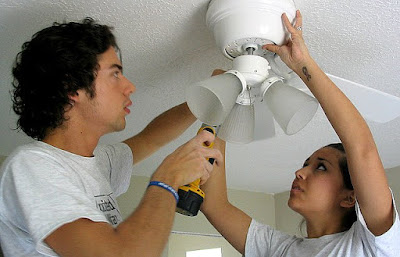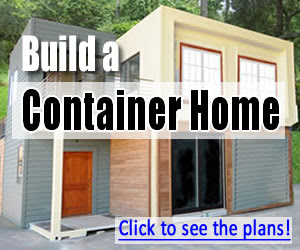It is pretty clear that shipping containers are affordable, innovative and practical when it comes to addressing shelter needs. It is however plausible to evaluate the use of containers to evaluate just how safe they are to the user and ecosystem at large. We also look at ways of making them pose less risk to the user and the environment.
Second hand shipping containers.
Most shipping container construction is done with used shipping containers of the boat. These are bought then fabricated to suit the taste and functionality. One major concern with this is the safety of the material used to manufacture the container. The manufacturers of these containers don't intend them to be used for housing or such other purposes at any point in their life span and therefore may use poisonous paints and solvents to make them more durable.The other thing that makes these used containers a risk to the user's health is that some carry dangerous chemicals that may spill and leave contaminants in the structure. If the contaminants are not detected and gotten rid of, they can be pose health risks to the users.
It is however possible to make a used shipping container safe by carrying out simple procedures before using them in construction.
� Securing the floors; Shipping container floors are usually covered with wood. The wood is treated with chemicals to give it a longer lease of life. When intending to use a second hand shipping container for construction, the first thing you should do is to call the original manufacturer to know whether the floor was treated using toxic chemicals. In the event this is so, you can make the floor safe by using non-breathable underlayment on it The non-breathable underlayment is laid directly on the original wooden floor. Tiles or other preferred flooring is then put on top.
� Securing the walls; In the event that you learn that the paints used are toxic, create a vapor barrier by spraying foam insulation on the inside wall. Your new home is now safe from toxic fumes. Paint the walls with water proof paint to prevent rusting and leakages. In case you are using them in a wilderness, use special paint that deters insects, rodents and other dangerous animals like snakes.
New shipping containers.
It is possible to get a shipping box straight from the manufacturer with the intent of using it for construction of residential houses. This makes them safe because the manufacturer is well aware of the intended use and therefore will refrain from using toxic paints or solvent in the container making process. However, getting a new container can be costly and doesn't add to the green resource cause.
Safety in extreme weather.
When asking yourself "are shipping containers safe to live in?" it is important to consider extreme weather factor. You home should be able to stand extreme weather like storms and hurricanes. Since these containers are designed to be stacked on one another in turbulent ocean weather, my bet is that they can stand harsh weather. Their popularity comes from the fact that they are sturdy, so much so that they stood the test of hurricane Katrina. The safety of shipping containers in bad weather and other natural disasters is clear as they are being used as emergency housing, medical centers and response dispatch centers in areas that have been hit with or are prone to natural calamities.
Security and comfort.
Just how secure and comfortable are shipping container homes? As a home owner� it gives you piece of mind to know that your home is burglar proof and secure even if you went away for months. Historically, the volume off lost goods declined significantly when shipping boxes were first put into use in the 50s. A container is built to be airtight and impenetrable once closed. For the most part, any alterations that come with construction and fabrications are responsible for compromise on security. It is important therefore to ensure that any additions and subtractions do not leave the container weak in any way or prone to breakages. To make the container more secure in cases where it is used in risky areas, leave the original structure intact. This will enable you to seal up whenever you have to go away for long.
When it comes to comfort, weather has to play a part. Hot and cold temperatures may prove uncomfortable if the container does not have proper ventilation and air conditioning. Most homes constructed from shipping containers are heat lagged and air conditions to ensure comfort. A container is quite spacious and one full length container can give the comfort of a studio apartment complete with indoor plumbing.
Shipping containers make it easy to put up housing units fast and at a low cost. Clearing the units is equally easy since most structures are welded and bolted in place after a foundation has been constructed.
It is quite safe, cheap and comfortable to live in a shipping container if you get everything right. Their modular structure designed to handle tough conditions and stacking make them perfect for storied building and construction in areas prone to harsh weather and earthquakes.
Building using containers is legal. However you have to check with your local authorities for regulations and guidelines of using containers, whether new or second hand for construction. Before using going for this option, make sure that there is a lot of space for machinery and the handling of these structures.
Title : Build a Container Home: Are Shipping Container Homes Safe To Live In - Angela's Blog
URL Link : Build a Container Home: Are Shipping Container Homes Safe To Live In - Angela's Blog
February 2016
All over the world, shipping container architecture is getting popular by the day. Not only is it becoming trendy but it is also taking center stage as effective, superior and sustainable alternative to traditional building materials. More to that, it is also getting accolades as being a green solution to affordable living, since there are millions of containers lying in stakeouts and ports, creating junk that needs to be put into good use All that said and done, one very important question remains i.e. are shipping container homes dangerous to live in? It is a question that deserves a comprehensive answer for those looking for home alternatives.
It is pretty clear that shipping containers are affordable, innovative and practical when it comes to addressing shelter needs. It is however plausible to evaluate the use of containers to evaluate just how safe they are to the user and ecosystem at large. We also look at ways of making them pose less risk to the user and the environment.
Second hand shipping containers.
Most shipping container construction is done with used shipping containers of the boat. These are bought then fabricated to suit the taste and functionality. One major concern with this is the safety of the material used to manufacture the container. The manufacturers of these containers don't intend them to be used for housing or such other purposes at any point in their life span and therefore may use poisonous paints and solvents to make them more durable.The other thing that makes these used containers a risk to the user's health is that some carry dangerous chemicals that may spill and leave contaminants in the structure. If the contaminants are not detected and gotten rid of, they can be pose health risks to the users.
It is however possible to make a used shipping container safe by carrying out simple procedures before using them in construction.
� Securing the floors; Shipping container floors are usually covered with wood. The wood is treated with chemicals to give it a longer lease of life. When intending to use a second hand shipping container for construction, the first thing you should do is to call the original manufacturer to know whether the floor was treated using toxic chemicals. In the event this is so, you can make the floor safe by using non-breathable underlayment on it The non-breathable underlayment is laid directly on the original wooden floor. Tiles or other preferred flooring is then put on top.
� Securing the walls; In the event that you learn that the paints used are toxic, create a vapor barrier by spraying foam insulation on the inside wall. Your new home is now safe from toxic fumes. Paint the walls with water proof paint to prevent rusting and leakages. In case you are using them in a wilderness, use special paint that deters insects, rodents and other dangerous animals like snakes.
New shipping containers.
It is possible to get a shipping box straight from the manufacturer with the intent of using it for construction of residential houses. This makes them safe because the manufacturer is well aware of the intended use and therefore will refrain from using toxic paints or solvent in the container making process. However, getting a new container can be costly and doesn't add to the green resource cause.
Safety in extreme weather.
When asking yourself "are shipping containers safe to live in?" it is important to consider extreme weather factor. You home should be able to stand extreme weather like storms and hurricanes. Since these containers are designed to be stacked on one another in turbulent ocean weather, my bet is that they can stand harsh weather. Their popularity comes from the fact that they are sturdy, so much so that they stood the test of hurricane Katrina. The safety of shipping containers in bad weather and other natural disasters is clear as they are being used as emergency housing, medical centers and response dispatch centers in areas that have been hit with or are prone to natural calamities.
Security and comfort.
Just how secure and comfortable are shipping container homes? As a home owner� it gives you piece of mind to know that your home is burglar proof and secure even if you went away for months. Historically, the volume off lost goods declined significantly when shipping boxes were first put into use in the 50s. A container is built to be airtight and impenetrable once closed. For the most part, any alterations that come with construction and fabrications are responsible for compromise on security. It is important therefore to ensure that any additions and subtractions do not leave the container weak in any way or prone to breakages. To make the container more secure in cases where it is used in risky areas, leave the original structure intact. This will enable you to seal up whenever you have to go away for long.
When it comes to comfort, weather has to play a part. Hot and cold temperatures may prove uncomfortable if the container does not have proper ventilation and air conditioning. Most homes constructed from shipping containers are heat lagged and air conditions to ensure comfort. A container is quite spacious and one full length container can give the comfort of a studio apartment complete with indoor plumbing.
Shipping containers make it easy to put up housing units fast and at a low cost. Clearing the units is equally easy since most structures are welded and bolted in place after a foundation has been constructed.
It is quite safe, cheap and comfortable to live in a shipping container if you get everything right. Their modular structure designed to handle tough conditions and stacking make them perfect for storied building and construction in areas prone to harsh weather and earthquakes.
Building using containers is legal. However you have to check with your local authorities for regulations and guidelines of using containers, whether new or second hand for construction. Before using going for this option, make sure that there is a lot of space for machinery and the handling of these structures.

















































